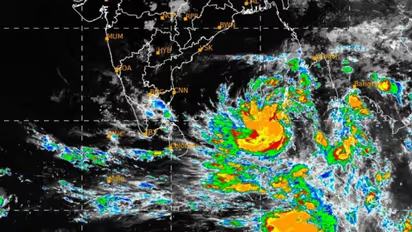Cyclone Asani: Do you know how cyclones are named?

Synopsis
According to the World Meteorological Organization (WMO), a United Nations body, many cyclones can exist at the same time in a specific geographical place or throughout the world, and the systems can endure for a week or more. As a result, each tropical storm is given a name in order to minimise misunderstanding and to aid in disaster risk awareness, management, and mitigation.
Cyclone Asani, which originated in the Bay of Bengal, is expected to grow into a severe cyclonic storm in the following 12 hours. Sri Lanka gave the name 'Asani.' Asani, which means 'wrath' in Sinhalese, will be the season's first cyclonic storm. But why do we give storms names? What really is in a name? How did the naming process begin? Here's all you need to know about cyclone naming.
According to the World Meteorological Organization (WMO), a United Nations body, many cyclones can exist at the same time in a specific geographical place or throughout the world, and the systems can endure for a week or more. As a result, each tropical storm is given a name in order to minimise misunderstanding and to aid in disaster risk awareness, management, and mitigation.
The India Meteorological Department (IMD) is one of six Regional Specialised Meteorological Centres (RSMCs) entrusted for naming cyclones that form over the northern Indian Ocean and achieve a maximum sustained surface wind speed of 62 kmph or higher. If the storm's wind speed hits or exceeds this threshold, it is categorised as a hurricane/cyclone/typhoon.
Also Read | Severe Cyclone Asani nears Odisha coast, heavy rainfall alert in several states
The list is organised according to the names supplied by alphabetically listed nations that are gender, political, religious, and culturally neutral. Once a name has been used, it will not be used again. The term, which can include up to eight letters, shall not be derogatory to any member country or damage the feelings of any demographic group.
The most current list, announced in 2020, has 169 names, including 13 names from each of 13 nations. Previously, eight nations had assigned 64 names. Gati (speed), Megh (cloud), and Akash are other Indian names that have been utilised. Other names used before were Ogni, Helen, and Fani from Bangladesh, and Laila, Nargis, and Bulbul from Pakistan.
The cyclone that forms after Asani will be known as Sitrang, a Thai name. WMO has already removed 'Ida' from the future list of names due to the storm's destructive and fatal nature. Short and easy-to-pronounce names are usually beneficial in properly communicating precise storm information amongst hundreds of scattered stations, coastal bases, and ships at sea.
Also Read | Cyclone Asani likely to intensify further; West Bengal, Odisha on high alert
Also Read | Odisha braces for cyclone; districts told to arrange safe shelters
Stay updated with the Breaking News Today and Latest News from across India and around the world. Get real-time updates, in-depth analysis, and comprehensive coverage of India News, World News, Indian Defence News, Kerala News, and Karnataka News. From politics to current affairs, follow every major story as it unfolds. Get real-time updates from IMD on major cities weather forecasts, including Rain alerts, Cyclone warnings, and temperature trends. Download the Asianet News Official App from the Android Play Store and iPhone App Store for accurate and timely news updates anytime, anywhere.